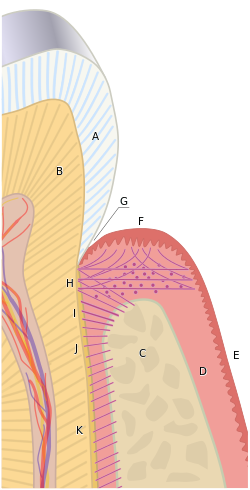Tooth and gingival interface
- The interface between a tooth and the surrounding gingival tissue is a dynamic structure.
- The gingival tissue forms a crevice surrounding the tooth, known as a sulcus.
- The sulcus is in a constant state of flux due to microbial invasion and immune response.
- The depth of the sulcus is approximately 2mm, consisting of junctional epithelium and gingival fiber attachment.
- The sulcus separates the surrounding epithelium from the tooth surface.
Gingival pocket
- A gingival pocket occurs when the marginal gingiva becomes edematous.
- Gingival hyperplasia can cause false pockets, with greater than normal periodontal probing measurements.
- The epithelial attachment remains at the same level, while the gingival margin migrates coronally.
- Gingivectomy may be necessary to reduce pocket depths.
- Gingival pockets are reversible when the cause of edematous reaction is eliminated.
Periodontal pocket
- Total loss of attachment (CAL) is the sum of gingival recession and probing depth.
- Periodontal pockets are lined by pocket epithelium instead of junctional epithelium.
- A probing measurement of 4mm or more clinically indicates a periodontal pocket.
- Irreversible destruction of gingival fibers occurs in periodontal pockets.
- Periodontal pockets can become infected and may require incision, drainage, and antibiotics.
Mucogingival defect
- A mucogingival defect occurs when destruction reaches the junction of attached gingiva and alveolar mucosa.
- The pocket violates the mucogingival junction.
- Mucogingival defects indicate advanced destruction of tissues.
Pocket formation
- Dental plaque is the starting point for pocket formation.
- Bacterial invasion from plaque triggers an inflammatory response.
- Continuous inflammation leads to tissue destruction and degradation of attachment and bone.
- Risk factors, such as diabetes and smoking, can worsen pocket formation.
- Proper oral hygiene measures, including interdental brushes, are essential for managing plaque levels.
This article needs additional citations for verification. (May 2016) |
Gingival and periodontal pockets (also informally referred to as gum pockets) are dental terms indicating the presence of an abnormal depth of the gingival sulcus near the point at which the gingival tissue contacts the tooth.
